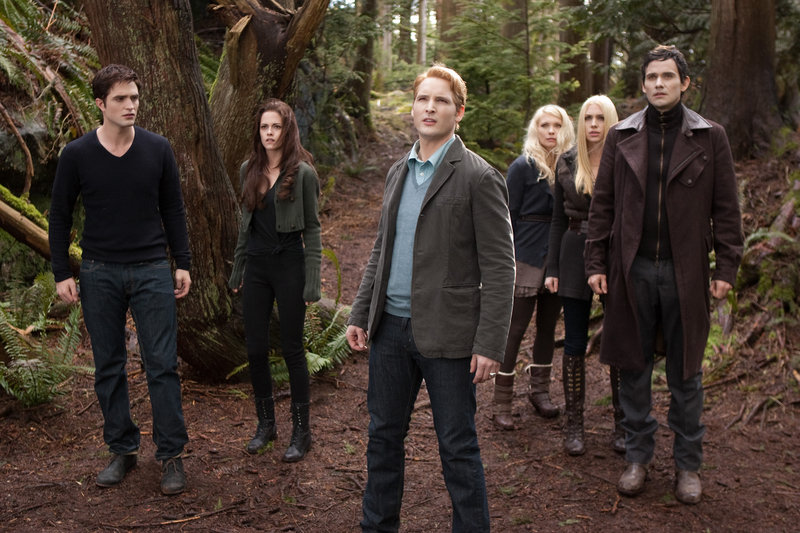Even after all this time, author Stephenie Meyer, the Mormon mother of three who became an overnight literary sensation with the 2005 publication of her young-adult novel “Twilight,” can’t explain the phenomenon that surrounds the grand romance between vampire Edward Cullen and human teenager Bella Swan, characters played on-screen by Robert Pattinson and Kristen Stewart.
“I don’t know what makes people love it, I don’t know what makes people hate it,” said Meyer. “But I do know that the feeling of being in love is a good feeling. We want to feel that emotion.”
“I’ve always said that,” Stewart said to Meyer, sitting beside her. “It’s so vicarious. It’s not like you are watching two people or reading two people. You feel like you are doing it. It’s rare.”
There’s no question that “Twilight” is that rare gem: a book and movie property that stokes a kind of unquenchable fire among its largely female fan base. That following has been so sizable and so fervent that the “Twi-hards,” as they’re called, have helped transform Meyer’s supernatural tale into a $2.5-billion business, proving that girl-centric tales can be powerful forces at the box office.
With the fifth and presumably final big-screen entry, “The Twilight Saga: Breaking Dawn — Part 2,” due to arrive in theaters Friday, Meyer and Stewart seem to share a bond reminiscent of the connection between Meyer’s two protagonists.
Their closeness stems from the unlikely duo’s joint goal of ensuring that the beloved material, for all its melodrama, remained intact as it was translated to the big screen. That required them to battle nervous studio executives who wanted Stewart’s interpretation of Bella to be less tortured, hardened detractors who railed against overwrought story lines and pop culture satirists who often turned the franchise into its own punch line.
Meyer had already made the leap from Arizona housewife to bestselling author when she first met Stewart, then an up-and-coming actress building her career primarily through roles in indie films. In the intervening years, Meyer’s stature and influence as a young-adult author became comparable to that enjoyed by J.K. Rowling or Suzanne Collins, though critics never responded to her writing the way enthusiastic readers did.
Stewart, however, has garnered plenty of acclaim — if not in the often tepidly reviewed “Twilight” movies, then in small challenging roles in films such as Sean Penn’s “Into the Wild” or Walter Salles’ upcoming adaptation of the Beat Generation classic “On the Road.” She’s also endured a tabloid celebrity she never planned for thanks to her on-again, off-again relationship with “Twilight” costar Pattinson.
Reaching the end of the saga was particularly satisfying for the actress, who seemed pleased to be able to take Bella to the happy if somewhat complicated conclusion of her journey — and to move on to the next phase of her career.
“I’m so ready to be done,” said the 22-year-old.
Directed like its predecessor by Oscar winner Bill Condon, “Breaking Dawn — Part 2” begins with Bella Swan as a newborn vampire and a new mother, whose half-human daughter, Renesmee, threatens to spark a war among tribes of vampires from around the globe. The ruling class in Italy, the Volturi, wrongly assume that Bella and Edward have transformed a human child into a vampire, something that is expressly forbidden, and gather forces to take down the entire Cullen clan.
The story line gave Stewart the opportunity to bring a new dimension to a character who’d always considered herself ordinary and clumsy; with her supernatural powers, she could be graceful and beautiful, lightning-fast and lethal.
“I played her as human for so long, so the enhanced version of her made so much sense to me,” said Stewart, her long limbs folded under her on the couch. “Everything so perfectly fit that I was so amped to do it.”
Meyer recalled standing in front of the monitor on the set of the film when Stewart shot her first scene as vampire Bella, nervously anticipating the outcome.
“We were dancing by the monitors — ‘Look at her go,”‘ Meyer said as Stewart pretended to leave the room, not wanting to hear the compliment. “It was such a huge weight lifted. It wasn’t a different character. It was Bella, but it was a totally different Bella. It was so exciting.”
The 700-page-plus “Breaking Dawn” novel was released just a few months before director Catherine Hardwicke’s adaptation of “Twilight” reached theaters in 2008. The book was met with controversy, even among Meyer’s loyal fans. Renesmee’s birth is an especially gruesome sequence — one that Condon had to carefully navigate for the previous PG-13-rated movie — and some readers complained about Bella’s choice to carry the child to term despite obvious risks to her own health.
There was also grumbling about an ending that felt too soft, too anticlimactic.
“I had a lot of concerns about making ‘Breaking Dawn’ a movie,” said Meyer, who holds final approval on the scripts for the “Twilight” films. “There were a lot of things they wanted to change. There were some serious problems.”
It was Meyer herself and screenwriter Melissa Rosenberg, who has written each of the five scripts for the films, who devised a new ending over dinner one night in Vancouver while the second “Twilight” movie, “New Moon,” was filming.
Of course, neither Meyer nor Stewart will reveal the new conclusion, but Meyer believes the solution is one fans will embrace.
Send questions/comments to the editors.


